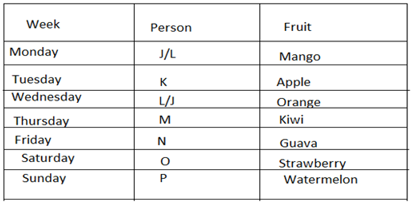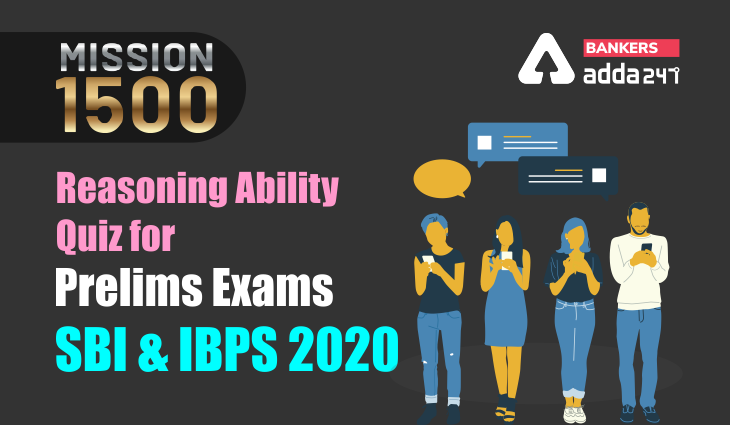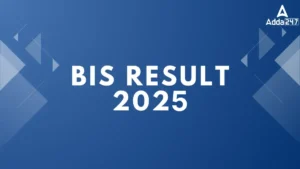Table of Contents
Directions (1-3): Study the information carefully and answer the questions given below.
In a family of eight members there are three married couples and five female members, G is daughter-in-law of B, who has two children. D is the aunt of C, D is unmarried. F is father-in-law of H and is married to E. A is the father of D.
Q1. How is H related to E?
(a) Son
(b) Grand father
(c) Son in law
(d) Daughter
(e) Husband
Q2. Who among the following is father of D?
(a) A
(b) F
(c) E
(d) G
(e) B
Q3. How is D related to G?
(a) Daughter-in-law
(b) Sister-in-law
(c) Sister
(d) Nephew
(e) Daughter
Q4. Pointing to a woman, Ravi said, “She is the daughter of my grandfather’s only child”. How is woman related to Ravi?
(a)Daughter
(b) Aunt
(c) Mother
(d) Sister
(e) None of these
Q5. Amit is the son of Shiv. Shiv’s sister, Jaya has a son Rohit and a daughter Yami. Riya is the mother of Amit’s father. How is Yami related to Riya?
(a) Mother
(b) Granddaughter
(c) Sister
(d) Niece
(e) None of these
Directions (6-10): Study the following information carefully and answer the given questions:
A group of seven persons –J, K, L, M, N, O and P like different fruits i.e. kiwi, mango, apple, guava, watermelon, orange and strawberry. They attend classes on different days of week starting from Monday to Sunday. No two persons has class on same day of the week.
N attends class on Friday. Only one person attends class between the one who likes guava and the one who likes watermelon. K likes apple. More than one person attends the class between the one who likes orange and the one who likes strawberry. N likes Guava. M likes kiwi. P attends class on Sunday. Only one person attends class between J and L. Neither the one who likes orange nor the one who likes kiwi attends the class on Saturday. K attends class on Tuesday. The one who likes mango attends the class before the one who likes apple.
Q6. How many persons attend the class between the one who likes orange and P?
(a) one
(b) two
(c) three
(d) more than three
(e) None of these
Q7.Who likes Watermelon?
(a) K
(b) L
(c) M
(d) P
(e) None of these
Q8.Who attends class on Thursday?
(a) J
(b) L
(c) M
(d) O
(e) None of these
Q9.Who attends class on Saturday?
(a) K
(b) O
(c) P
(d) L
(e) None of these
Q10. If K is related to Mango and N is related to Kiwi, then in the similar way, P is related to?
(a) Apple
(b) Orange
(c) Strawberry
(d) Kiwi
(e) Cannot be determined
Directions (11-15): The following questions are based on the five three – digit numbers given below:
924 574 456 187 675
Q11. If 3 is added to the second digit of each of the numbers how many numbers thus formed will be divisible by three?
(a) None
(b) One
(c) Two
(d) Three
(e) None of these
Q12. If all the digits in each of the numbers are arranged in descending order within the number, which of the following will be the highest number in the new arrangement of numbers?
(a) 924
(b) 574
(c) 456
(d) 187
(e) 675
Q13. What will be the resultant number if the third digit of the second highest number is divided by the 2nd digit of the second lowest number?
(a) 2
(b) 3
(c) 0
(d) 1
(e) 4
Q14. If 3 is added to the first digit and 1 is added to the last digit of each of the number then which of the following numbers will be the second highest number?
(a) 924
(b) 574
(c) 456
(d) 187
(e) 675
Q15. If in each number the first and the third digits are interchanged then which will be the highest number?
(a) 924
(b) 574
(c) 456
(d) 187
(e) 675
Practice More Questions of Reasoning for Competitive Exams:
Solutions
Solution (1-3):
Sol.

S1.Ans.(c)
S2.Ans.(a)
S3.Ans.(b)
S4.Ans.(d)
S5.Ans.(b)
Solution (6-10):
Sol.

S6.Ans. (c)
S7.Ans. (d)
S8.Ans.(c)
S9.Ans.(b)
S10.Ans.(c)
S11. Ans. (d)
S12. Ans. (a)
S13. Ans. (d)
S14. Ans. (e)
S15. Ans. (d)
Practice with Crash Course and Online Test Series for IBPS Clerk Prelims:
- Bank Test Pack Online Test Series (12 Months)
- IBPS PO and Clerk Prime 2020-21 Online Test Series
- SBI PO Prime 2020-21 Online Test Series
Click Here to Register for Bank Exams 2020 Preparation Material




 GA Capsule for SBI Clerk Mains 2025, Dow...
GA Capsule for SBI Clerk Mains 2025, Dow...
 The Hindu Review October 2022: Download ...
The Hindu Review October 2022: Download ...
 BIS Result 2024-25 Out for ASO, JSA and ...
BIS Result 2024-25 Out for ASO, JSA and ...





